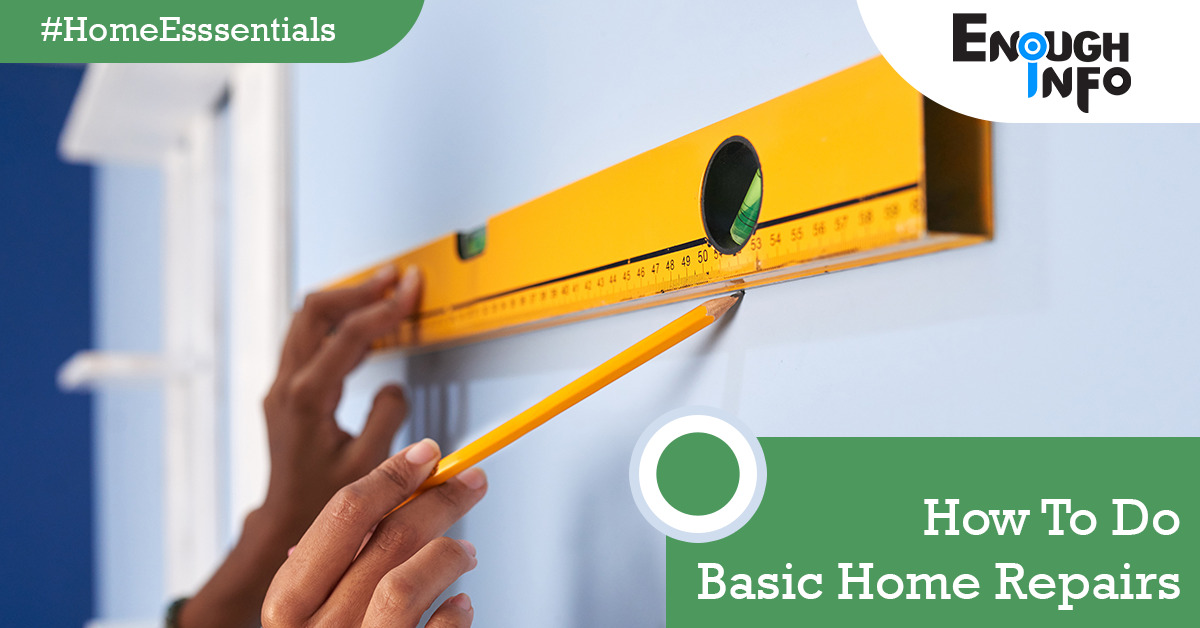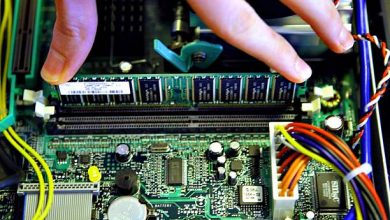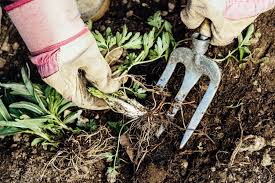How To Do Basic Home Repairs

How To Do Basic Home Repairs: Keeping your home in good condition requires regular maintenance and occasional repairs. While major repairs may require professional assistance, learning basic home repair skills empowers homeowners to tackle common issues and save money in the process. EnoughInfo.com

Read Also: How To Make Homemade Natural Cleaning Products
Knowing how to do basic home repairs is important for cost savings, timely maintenance, home safety, property value preservation, independence, skill development, emergency preparedness, and customization. By taking the time to learn and practice basic repairs, you become a more capable and confident homeowner, able to address issues efficiently and maintain a safe and functional living environment. How To Do Basic Car Painting (All You Need To Know)
FAQs & Answers on How to do basic home repairs
1. Can I do basic home repairs myself, or should I hire a professional?
The answer to this question depends on your skill level and comfort with DIY projects. Basic home repairs, such as fixing a leaky faucet or replacing a light switch, can often be done by homeowners with some basic tools and knowledge. However, if you’re unsure about a repair or dealing with complex issues, it’s best to hire a professional to avoid causing further damage or compromising your safety.
2. What tools do I need for basic home repairs?
The tools required for basic home repairs can vary depending on the specific repair task. However, some common tools that come in handy for many repairs include a set of screwdrivers (both flathead and Phillips), an adjustable wrench, pliers, a utility knife, a hammer, a tape measure, a level, a flashlight, and a voltage tester for electrical work. It’s a good idea to have a basic toolkit with these essential tools readily available for any repair needs that may arise. How To Make A DIY Face Mask For Glowing Skin
3. Are there any safety precautions I should take when doing home repairs?
Yes, safety should always be a top priority when performing home repairs. Here are some essential safety precautions to keep in mind:
- Turn off the power: When working on electrical repairs, always turn off the power at the circuit breaker or fuse box to avoid the risk of electrical shock.
- Wear protective gear: Depending on the task, wear appropriate protective gear such as safety glasses, gloves, and a dust mask to protect yourself from potential hazards.
- Use tools correctly: Familiarize yourself with the proper use of tools and follow the manufacturer’s instructions. Improper tool usage can lead to accidents or injuries.
- Take precautions with ladders: If your repair requires using a ladder, ensure it is stable and on a level surface. Follow ladder safety guidelines and avoid overreaching or leaning too far.
- Follow instructions and codes: When working with plumbing, electrical, or structural repairs, follow the manufacturer’s instructions and adhere to local building codes to ensure proper installation and safety.
A Comprehensive Guide to Basic Home Repairs: Mastering DIY Skills for a Well-Maintained Home

In this comprehensive guide, we will walk you through essential DIY home repairs, providing step-by-step instructions, tips, and safety precautions to help you become proficient in handling basic repairs around your home.
Essential Tools for DIY Repairs
When it comes to DIY home repairs, having the right tools is essential. Here are some of the basic tools that every homeowner should have in their toolbox:
1. Hammer
A claw hammer is a versatile tool for driving and removing nails, as well as light demolition work.
2. Screwdrivers
Invest in a set of screwdrivers that includes both flathead and Phillips head screwdrivers in various sizes. These are useful for assembling furniture, tightening screws, and many other household tasks. How To Teach A Parrot To Talk
3. Adjustable Wrench
Also known as a crescent wrench, an adjustable wrench is used for tightening or loosening nuts and bolts of different sizes. It’s a versatile tool that can be adjusted to fit various fasteners.
4. Pliers
A pair of slip-joint pliers and needle-nose pliers are handy for gripping, bending, and cutting wires, as well as holding small objects securely.
5. Tape Measure
A tape measure is essential for taking accurate measurements for furniture placement, hanging artwork, or determining the dimensions of materials for repairs or renovations.
6. Level
A spirit level ensures that shelves, pictures, and other items are correctly aligned. It helps you achieve a straight and balanced finish.
7. Utility Knife
A utility knife is useful for cutting through various materials, such as cardboard, packaging, or carpet. Make sure to have spare blades on hand as they can dull quickly. How To Clean Grout Between Tiles
8. Cordless Drill
A cordless drill with interchangeable drill bits and screwdriver bits is a versatile tool for drilling holes and driving screws. Look for one with adjustable speed settings and a rechargeable battery. How To Play The Flute For Beginners
9. Saw
Depending on your needs, a handsaw or a circular saw can be helpful for cutting through wood, plastic, or other materials during home improvement projects or repairs.
10. Safety Gear
Don’t forget to include safety equipment like safety goggles, work gloves, and a dust mask. These protect you from debris, sharp objects, and harmful particles during repairs.
11. Toolbox
A sturdy toolbox keeps your tools organized and easily accessible. Choose one with compartments or a removable tray to keep everything in order.
Read Also: How to Declutter And Organize Your Home
Safety Precautions and Guidelines
Safety should always be a top priority when performing DIY home repairs. Here are some essential safety precautions and guidelines to follow:
1. Wear Protective Gear
Always wear appropriate protective gear, such as safety goggles, work gloves, and a dust mask, to safeguard yourself from potential hazards, flying debris, and harmful substances.
2. Use Tools Properly
Familiarize yourself with the correct use of each tool before using it. Read the instruction manuals, follow safety guidelines, and use tools only for their intended purposes. How To Clean Grout Between Tiles
3. Power Tool Safety
When using power tools, ensure they are in good working condition and have safety features like guards and switches. Disconnect power sources when changing blades or bits, and use clamps or other secure methods to hold the workpiece in place.
4. Practice Electrical Safety
When working with electrical systems or appliances, turn off the power at the circuit breaker or unplug them before starting any repairs. Use a non-contact voltage tester to ensure there is no live current. If you’re unsure about electrical work, consult a qualified electrician.
5. Be Cautious with Ladders and Scaffolding
When working at heights, use stable and properly secured ladders or scaffolding. Follow weight capacity guidelines and maintain three points of contact with the ladder at all times.
6. Mind Your Surroundings
Keep your work area clean and free from clutter. Be aware of tripping hazards, sharp objects, and other potential dangers. Ensure good lighting in the work area to avoid accidents.
7. Use Personal Protective Equipment (PPE)
For specific tasks like painting, sanding, or working with chemicals, use additional PPE as needed, such as respirators, ear protection, or protective clothing.
8. Read Material Safety Data Sheets (MSDS)
If using chemicals or solvents, familiarize yourself with their proper handling and storage guidelines by reading the MSDS. Follow the recommended safety precautions and use them in well-ventilated areas.
9. Work with a Buddy
If possible, have someone nearby while working on projects that may require assistance or in case of emergencies.
10. Know Your Limits
Be honest with yourself about your skills and knowledge. If a repair task exceeds your capabilities or involves complex systems, it’s best to seek professional help to avoid potential risks or further damage.
11. Educate Yourself
Stay informed about safety practices and guidelines related to home repairs. Keep up to date with best practices through reliable sources, instructional videos, or workshops.
Plumbing Repairs
1. Fixing a Leaky Faucet
A leaky faucet is not only annoying but can also waste a significant amount of water over time. Fortunately, fixing a leaky faucet is a relatively simple repair that you can do on your own. Here’s a step-by-step guide:
- Turn off the water supply: Locate the shut-off valve under the sink and close it to stop the water flow.
- Disassemble the faucet: Use a screwdriver or an Allen wrench to remove the handle of the faucet. Next, unscrew the packing nut that holds the valve assembly together. Take note of the order in which the parts are assembled for easy reassembly.
- Replace the faulty parts: Inside the valve assembly, you’ll find a rubber washer or O-ring that is likely causing the leak. Remove the old washer or O-ring and replace it with a new one of the same size and shape. If the cartridge or valve seat is damaged, consider replacing them as well. How To Start A Successful Blog
- Reassemble the faucet: Put the faucet parts back together in the reverse order of disassembly. Ensure everything is tightly secured but avoid overtightening, as it may lead to other issues.
- Turn on the water supply: Slowly open the shut-off valve to allow water to flow to the faucet. Check for any leaks and make adjustments if necessary.
Read Also: How to fix a leaky faucet(The Ultimate Guide)
2. Clearing a Clogged Drain
Dealing with a clogged drain is a common household issue that can be easily resolved without calling a plumber. Here’s how you can clear a clogged drain using basic tools and household items:
- Remove any visible debris: Use a pair of gloves to remove hair, food particles, or any other visible debris from the drain opening. Dispose of the debris in a trash bag. How To Make Homemade Natural Cleaning Products
- Try a plunger: If the clog persists, use a plunger. Fill the sink or tub with enough water to cover the plunger cup. Place the plunger over the drain and push it down firmly, then pull up quickly. Repeat this plunging motion several times to dislodge the clog. If the clog is in a double sink, block the other drain with a wet cloth or stopper to create pressure.
- Use a drain snake: If the plunger doesn’t work, you can try using a drain snake. Insert the snake into the drain and rotate it clockwise while pushing it forward. Continue pushing and rotating the snake until you feel resistance. This indicates that the snake has reached the clog. Wiggle and pull the snake to break up the clog or pull it out.
- Make a homemade drain cleaner: If the clog is not severe, you can try a homemade drain cleaner. Mix 1/2 cup of baking soda with 1/2 cup of vinegar and pour it down the drain. Let it sit for 15-20 minutes, then flush it with hot water. This mixture helps dissolve grease and grime buildup.
- Prevent future clogs: To prevent future clogs, use drain screens or strainers to catch debris before it enters the drain. Avoid pouring grease, oil, or coffee grounds down the drain, as they can solidify and cause blockages.
3. Repairing a Running Toilet
A running toilet can waste a significant amount of water and inflate your water bill. Repairing it is a relatively simple task that requires minimal tools. Here’s how you can fix a running toilet:
- Identify the problem: Remove the tank cover and observe the flushing mechanism. If the water continuously runs into the overflow tube, the flapper valve is likely not sealing properly. If the water level is too high and spills into the overflow tube, the fill valve may need adjustment or replacement. How To Do Basic Car Painting (All You Need To Know)
- Adjust the flapper valve: If the flapper valve is not sealing properly, it may need adjustment. Locate the chain attached to the flapper and adjust its length so that it allows the flapper to close completely. If the flapper is damaged or worn out, replace it with a new one.
- Check the fill valve: If the water level is too high, the fill valve may be the culprit. Locate the fill valve, usually located on the left side of the toilet tank, and adjust the float mechanism. Lowering the float will reduce the water level. If the fill valve is faulty, consider replacing it with a new one.
- Inspect the fill tube: The fill tube is a small flexible tube that refills the toilet bowl after flushing. Ensure that it is properly connected to the overflow tube and that it is not obstructed or damaged. If necessary, adjust or replace the fill tube.
- Test and make adjustments: After making the necessary repairs and adjustments, flush the toilet and observe its behavior. The water should stop running once the tank is refilled, and there should be no leaks or continuous running. Make further adjustments if needed to achieve proper functioning.
- Consider professional help: If the issue persists or if you are uncomfortable handling toilet repairs, it is advisable to seek the assistance of a professional plumber. They can diagnose and resolve any complex problems with your toilet.
By learning to handle basic plumbing repairs, you can save money on plumber fees and address common issues promptly. However, it’s essential to know your limits and seek professional assistance when dealing with complex plumbing problems or if you are unsure about any repair procedures.
Read Also: How To Unclog A Double Kitchen Sink
Electrical Repairs
1. Changing a Light Fixture
Changing a light fixture is a simple electrical repair that can instantly update the look of a room. Follow these steps to safely replace a light fixture:
- Turn off the power: Before starting any electrical work, turn off the power to the light fixture at the circuit breaker or fuse box. Use a voltage tester to ensure that the power is completely off.
- Remove the old fixture: Unscrew the screws or nuts that hold the old fixture to the electrical box. Carefully disconnect the wires by unscrewing the wire nuts and separating the connections. Take note of the wire colors and how they were connected.
- Install the new fixture: Attach the mounting bracket of the new fixture to the electrical box using the provided screws. Connect the wires by matching the colors: black to black (hot), white to white (neutral), and green or copper to the grounding wire. Use wire nuts to secure the connections and ensure they are tight. How To Play The Flute For Beginners
- Mount the new fixture: Secure the new fixture to the mounting bracket using the included screws or nuts. Follow the manufacturer’s instructions for proper installation.
- Restore power and test: Once the new fixture is securely mounted, turn the power back on at the circuit breaker or fuse box. Turn on the light switch to test the fixture and ensure it is working correctly.
2. Replacing a Light Switch
Over time, light switches can wear out or become faulty. Replacing a light switch is a relatively easy electrical repair that can be done in a few steps:
- Turn off the power: As with any electrical work, turn off the power to the switch at the circuit breaker or fuse box. Use a voltage tester to verify that the power is off.
- Remove the old switch: Unscrew the switch cover plate and carefully pull it away from the wall. Unscrew the mounting screws that hold the switch in place and gently pull it out. Take note of how the wires are connected to the switch.
- Disconnect and reconnect wires: Loosen the terminal screws on the old switch and disconnect the wires. Pay attention to the wire colors and the screws they were attached to. Connect the wires to the corresponding screws on the new switch and tighten the terminal screws.
- Mount the new switch: Gently push the new switch into the electrical box and secure it with the mounting screws. Ensure that the switch is aligned properly and sits flush against the wall. Attach the switch cover plate and screw it into place.
- Restore power and test: Turn the power back on at the circuit breaker or fuse box. Test the new switch by turning it on and off to ensure proper functionality.
3. Fixing an Electrical Outlet
If an electrical outlet is not working or becomes loose, you can attempt to fix it yourself. However, if you are uncertain about working with electrical wiring, it’s best to consult a professional electrician. Here are some basic steps to fix a faulty electrical outlet:
- Turn off the power: Turn off the power to the outlet at the circuit breaker or fuse box. Confirm that the power is off using a voltage tester.
- Remove the outlet cover plate: Unscrew the screws holding the cover plate in place and carefully remove it. Take note of the wiring connections.
- Check the wiring connections: Inspect the wiring connections at the outlet. Make sure they are secure and tight. If any wires are loose or disconnected, carefully reconnect them to the appropriate terminals.
- Test the outlet: Turn the power back on at the circuit breaker or fuse box. Use a voltage tester to ensure that the outlet is receiving power. If the outlet is still not working, proceed with the following steps:
- Check for tripped GFCI outlets: Some outlets are connected to ground fault circuit interrupters (GFCIs) that protect against electrical shocks. Look for any nearby GFCI outlets and press the reset button if it’s tripped. This may restore power to the non-functioning outlet.
- Replace the outlet: If the outlet still doesn’t work after checking the wiring and resetting any GFCIs, it may be faulty and need replacement. Turn off the power again and carefully remove the outlet from the electrical box. Disconnect the wires from the terminals and connect them to the corresponding terminals on the new outlet. Secure the new outlet in the electrical box, attach the cover plate, and restore power to test its functionality.
- Seek professional help: If you are unsure about any electrical repairs or encounter complex issues, it is best to consult a licensed electrician. They have the expertise to handle more intricate electrical problems and ensure your safety.
Remember to always prioritize safety when working with electricity. If you’re unsure about any step or encounter unfamiliar wiring, consult a professional to avoid the risk of electrical hazards or injury.
Painting and Wall Repairs
1. Patching Drywall Holes
Holes in drywall can be an eyesore, but they are relatively easy to patch. Follow these steps to repair small to medium-sized holes in drywall:
Read Also: How To Drill Into Stucco(Step by Step)
- Prepare the area: Clean the hole and remove any loose debris or protruding edges. Use a utility knife or sandpaper to create a clean, smooth edge around the hole.
- Apply a patch: Cut a piece of drywall or use a self-adhesive mesh patch slightly larger than the hole. Place the patch over the hole, ensuring it covers the entire damaged area.
- Secure the patch: Apply a thin layer of joint compound over the patch, extending it beyond the edges to blend with the surrounding wall. Smooth the compound using a putty knife, ensuring it is evenly applied.
- Allow the compound to dry: Follow the manufacturer’s instructions for drying time. Once dry, lightly sand the patch with fine-grit sandpaper to create a smooth surface.
- Apply additional layers: If necessary, apply additional layers of joint compound, allowing each layer to dry and sand in between until the patch is flush with the wall.
- Prime and paint: After the final layer is dry and sanded, prime the patched area to ensure a uniform paint finish. Once the primer is dry, apply paint that matches the surrounding wall, blending it with the rest of the surface.
Applying a Fresh Coat of Paint
Applying a fresh coat of paint is one of the most effective ways to refresh the look of a room. Follow these steps for a successful paint job:
- Prepare the surfaces: Remove any furniture, fixtures, and wall decorations from the room. Protect the floor and any remaining items with drop cloths or plastic sheets. Clean the walls to remove dust, dirt, and grease.
- Repair any damage: Patch any holes, cracks, or imperfections in the walls using a spackle or joint compound. Allow the repairs to dry, then sand them smoothly.
- Prime the walls (if necessary): If you’re painting over a dark color or stained surface, consider applying a coat of primer. This will help achieve better color coverage and uniformity.
- Choose the right paint: Select a high-quality paint that is appropriate for the surface you’re painting. Consider the finish (e.g., matte, satin, semi-gloss) based on your desired look and the room’s purpose.
- Gather the necessary tools: Ensure you have the right tools on hand, including paint brushes, rollers, paint trays, painter’s tape, and a drop cloth.
- Prepare the paint: Stir the paint thoroughly to ensure an even consistency. If necessary, thin the paint according to the manufacturer’s instructions.
- Start painting: Begin by cutting in the edges of the walls using a brush, painting around corners, trim, and ceiling lines. Use smooth, even strokes, and take your time for a clean and precise finish.
- Roll the walls: Once the edges are painted, use a roller to apply paint to the larger sections of the walls. Start from the top and work your way down, using long, vertical strokes. Overlap each stroke slightly for even coverage.
- Allow the paint to dry: Follow the paint manufacturer’s instructions for drying time. It’s important to allow each coat to dry completely before applying additional coats.
- Apply additional coats (if necessary): Depending on the desired color intensity and coverage, you may need to apply multiple coats of paint. Allow each coat to dry before applying the next, and check for any missed spots or uneven areas.
- Clean up: Once you have finished painting, clean your brushes and rollers with water or the appropriate cleaning solution. Remove the painter’s tape before the paint is fully dry to prevent peeling.
- Enjoy your freshly painted space: Allow the paint to fully cure according to the manufacturer’s instructions before moving furniture back into the room and rehanging decorations.
By learning basic home repair skills, you can save money, maintain your home’s condition, and enhance its aesthetics. Always prioritize safety and take necessary precautions when performing any repair or maintenance tasks. If you encounter more complex issues or feel uncomfortable handling certain repairs, it’s best to consult professionals to ensure the job is done properly and safely.
Read Also: How To Create A DIY Home Decor
Conclusion
Homeowners benefit from learning fundamental house maintenance. Self-repairs save money, give you independence, and improve house maintenance. With knowledge, planning, and practice, many repairs may be done without professional help. This article has covered basic house repairs, including typical repairs homeowners may do, required tools and safety measures, common mistakes to avoid, and techniques to build repair confidence. We’ve also answered frequently asked questions.
Remember to prioritize safety, start small, and expand your home repair abilities and knowledge. To improve your repair skills, consult online courses, books, workshops, and professionals. Always prioritize your safety and your home’s integrity by asking for help.
By learning fundamental house repairs, you can manage your living environment, save money, and enjoy maintaining and upgrading your home. Roll up your sleeves, grab your tools, and enjoy the gratifying path of becoming a more self-reliant and confident homeowner.
Recommended;
How To Soften Grout For Removal
The Benefits Of A Minimalist Lifestyle And How To Adopt It




